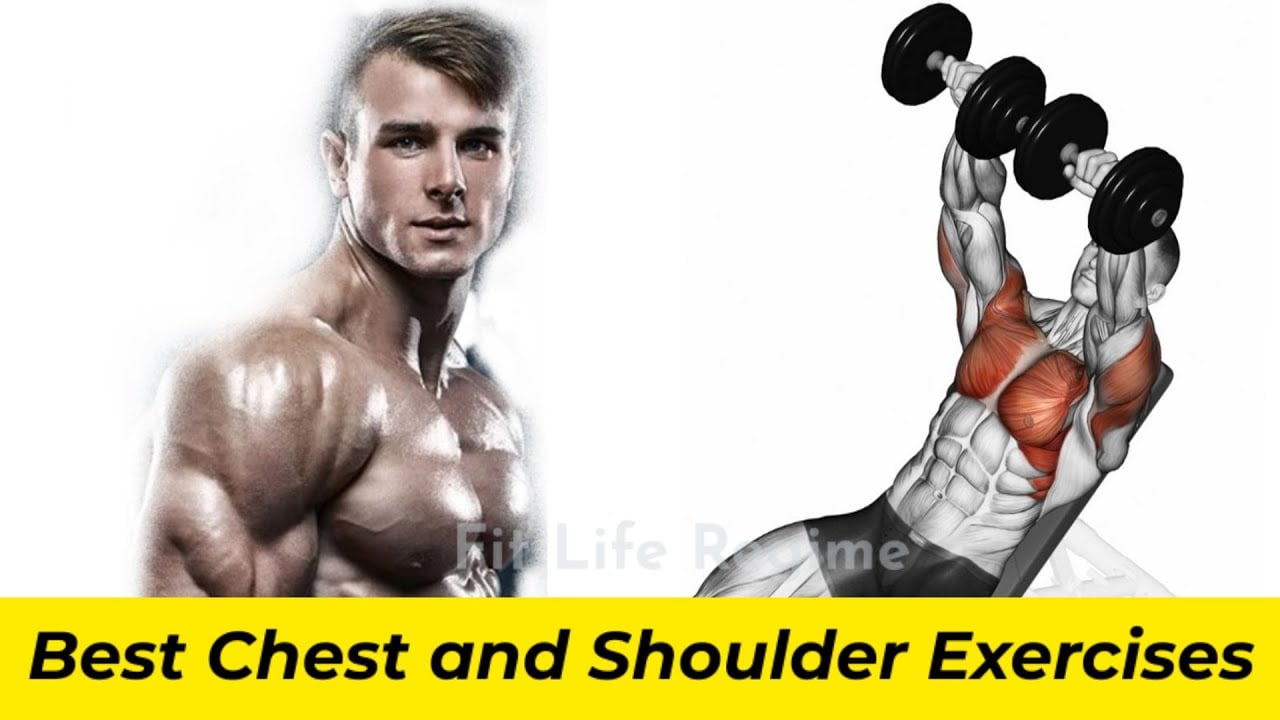Are you ready to take your upper body workout to a new level? Then you must train your chest and shoulders in the same workout.
Why? Because this dynamic duo of chest and shoulder workout is the key to explosive power, incredible strength, and a sculpted physique that screams confidence
The chest and shoulders have long been recognized as a classic muscle pair, closely associated with exercises such as the bench press. This connection is essential because while the chest muscles are key players during pressing movements, the shoulders are important synergistic partners.
But we’re not just doing any old workout here. We’re taking this workout to a new level with a new technique. This means less rest, more intensity, and maximum muscle growth for your chest and shoulders.
Let’s explore them one by one!
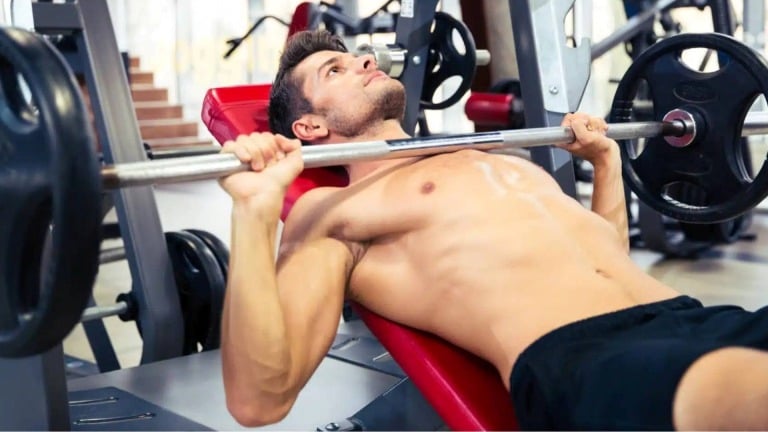
- Benefits Of Training Chest and Shoulder Together
- 1. Muscular Synergy
- 2. Balanced Upper Body Development
- 3. Time Efficiency
- 4. Increased Training Frequency
- 12 Best Chest And Shoulder Workouts
- 1. Barbell Bench Press
- 2. Decline Bench Press
- 3. Incline Bench Press
- 4. Cable Crossover
- 5. Dumbbell Fly
- 6. Push-Ups
- 7. Overhead Press
- 8. Machine Press
- 9. Lateral Raise
- 10. Dumbbell Front Raise
- 11. Upright Row
- 12. Rear Delt Fly
- How To Do Chest Shoulder Workouts (With Routines)
- 1. Weekly Workout Sets
- 2. Select Reps Range Based On Goals
- 3. Design Your Chest and Shoulder Workout Split
- 4. Beginner Chest and Shoulder Workout Routine
- 5. Intermediate Workout Routine
- 6. Advanced Workout Routine
- 7. Chest and Shoulder Superset Workout
- FAQs
- Can you train the chest and shoulder together?
- How Many Sets and Reps Should I Do?
- Should I do shoulders on chest day?
- References
Benefits Of Training Chest and Shoulder Together
Training the chest and shoulders together in the same workout offers several advantages contributing to well-rounded upper body development. The reasons for training those muscle groups together are very logical.
1. Muscular Synergy
During a compound workout, many targeted muscles work together with other Synergistic and stabilizer muscles to function.
The target of one muscle may not fully engage the other supportive muscles, but they may be in use to some degree. So, if a workout targets one specific muscle group, the groups that work along with that muscle also get some work.
When doing a bench press, one of the target muscles is the chest. However, other muscles work in this motion, such as the triceps and the muscles in the shoulders.
2. Balanced Upper Body Development
Training them together can help you build muscles proportionally and prevent muscle imbalances. This balanced growth makes you look better and strengthens your upper body.
3. Time Efficiency
Combining chest and shoulder exercises into a single workout saves time because you can train multiple muscle groups simultaneously. This can be particularly beneficial if you have a busy schedule or limited time for training.
4. Increased Training Frequency
It allows for higher training frequency. Since these muscle groups are frequently used in various upper body movements, targeting them together will enable you to train them more frequently throughout the week.
Note: It’s important to let you know that we strongly believe in first training your chest before your shoulder during your workout routine. This is because your chest muscle will need your full energy and is most likely the heaviest to train and gain in terms of muscle.
12 Best Chest And Shoulder Workouts
Below is a list of the best chest and shoulder workouts for building a strong and healthy body and muscle. The first six are chest-focused exercises, and the other six are shoulder-focused exercises.
1. Barbell Bench Press
The flat barbell bench press often called the bench press, is a compound exercise essential for anyone looking to build a strong and well-developed chest.
This exercise works your chest muscles, triceps, and shoulders, so it’s really good for strengthening your upper body.
It is no wonder it is a staple of the training routines of athletes, bodybuilders, and fitness enthusiasts of all levels.
Barbell Bench Press Variations
- Incline Barbell Bench Press: Mainly targets the upper chest muscles.
- Decline Barbell Bench Press: Mainly targets the lower chest muscles.
- Close-Grip Bench Press: Mainly targets the triceps muscles more than the chest.
- Reverse Grip Bench Press: focuses most on the upper pecs and tricep.
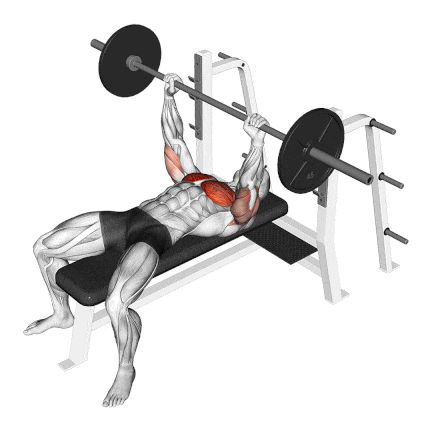
How To Do
- Lie flat on a bench with your feet on the ground and your eyes directly underneath the barbell.
- Grab the barbell with a grip that is slightly wider than shoulder-width apart.
- Lift the barbell off the rack and lower it towards your chest in a controlled manner.
- Press the barbell back up towards the starting position, until your arms are nearly locked out.
Know More: Barbell Chest Exercises for Bigger and Stronger Pecs
2. Decline Bench Press
The decline bench press is an effective flat bench alternative that changes the angle and tension placed on the chest, increasing the likelihood of new stimulus to the working muscle and, therefore, the b probability of muscle growth in size and strength.
The decline press exercise is much better than the flat bench press for building your lower chest muscles, which gives your chest a fuller, denser, more attractive look.
To do the decline bench press, you’ll need a specialized decline bench that puts the back pad at about a 15-30 degree angle.
Here are a few variations to keep your decline press workouts challenging and effective:
- Barbell Decline Press: The classic. It’s great for heavy loads and building overall strength.
- Dumbbell Decline Press: This exercise allows for a greater range of motion and more independent movement of each arm. (It also fixes muscle imbalances.)
- Machine Decline Press: Offers a guided motion path and is a good option for beginners or those needing extra support.
- Decline Smith Machine Press: increasing stability and allowing the lifting of heavier weights.
- Cable Decline Press: Adds constant tension throughout the movement.
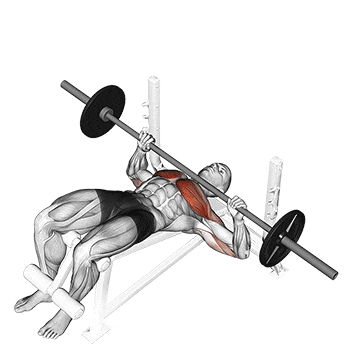
How To Do
- Lie on a decline bench and secure your legs at the end.
- Lift the bar from the rack using a shoulder-width overhand grip on the bar. Hold it over yourself with your arms locked.
- Bring the bar down slowly until you feel the bar on your chest. Pause slightly at this point.
- As you exhale, move the bar back up to the starting position. Use your chest muscles to push the bar.
- Hold for a second, and then slowly bring the bar down again.
3. Incline Bench Press
If you want to build greater thickness and strength in your upper pecs, then you should add incline dumbbell bench press to your training regime.
The incline dumbbell bench press aka dumbbell incline Chest press is an upper body workout that engages the upper pec muscles, the triceps, and the anterior deltoid muscles of the shoulders.
Research shows that doing the Incline bench press at a 30-degree angle is the best way to work on the upper part of your chest.
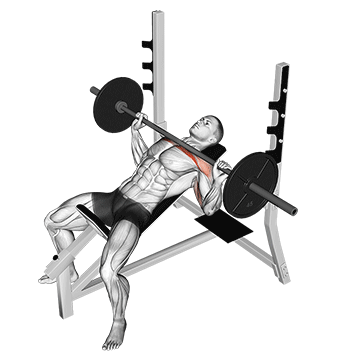
How To Do
- Set a bench at about 30-45 degrees inclined. Do not go more upright as the stress shifts more to the shoulders rather than the chest area.
- Lie back on an incline bench.
- Lift the bar from the rack using a shoulder-width overhand grip on the bar. Hold it over yourself with your arms locked.
- Bring the bar down slowly until you feel the bar on your chest. Pause slightly at this point.
- Raise your arms until they are nearly locked out. Repeat for the desired number of repetitions.
4. Cable Crossover
Cable Fly, aka Cable Crossover fly, helps to build massive Pectorals. Crossover provides constant tension in helping build massive pecs.
It also helps to develop and define the Inner and lower chest muscles. Cable provides constant resistance and helps develop the lower and the central chest muscles by providing the much-needed stress in the lower and the inner pecs.
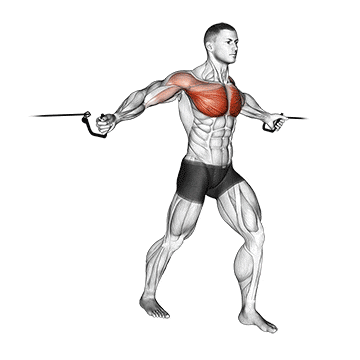
How To Do
- In a standing position, grab and hold the handles of overhead pulleys on both sides.
- Bend slightly forward and extend your arms, feeling a good stretch in your chest muscles.
- Now, flex your arms with elbows slightly bent and get a good chest contraction.
- Unlike chest flies, you can cross over the center to get full Pec contraction.
5. Dumbbell Fly
The dumbbell fly is an isolation exercise usually performed after big compound lifts like the bench and incline press.
It is considered to be the perfect finishing move and a great way to focus on your chest after many pressing exercises.
The chest fly doesn’t require much equipment to perform. You can do dumbbell flyes while lying on the floor if you don’t have a bench.
Different Fly Exercises To Develop Your Chest
- Standing Dumbbell Fly
- Decline Dumbbell Fly
- Decline Cable Fly
- Incline Cable Fly
- Incline Dumbbell Chest Fly
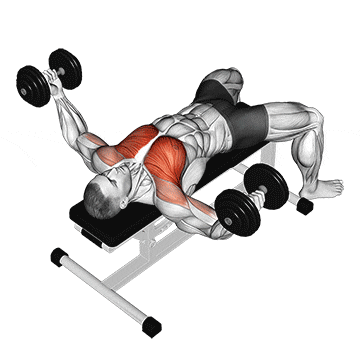
How To Do
- Lie on the flat bench with your feet flat on the floor.
- Lift your arms straight up from your shoulders and the dumbbells directly over your upper chest.
- Slowly lower your arms to your sides until your wrists reach about shoulder level or slightly above.
- Bring your arms back toward the midline of your body, focusing on using your pec muscles to draw them back together.
6. Push-Ups
Push-Ups are a popular bodyweight exercise that works for multiple muscle groups, making it a good workout for strengthening the upper body.
While push-ups primarily target the chest muscles, they also engage several other muscles, including the shoulders, triceps, and core.
There are many ways to do push-ups, including different foot positions and body angles. The most common ones are:
- Standard Push Ups: It helps you build your chest, shoulders, and tricep muscles.
- Incline Push Ups: Because of the angle, the Incline push up works your lower chest and core more.
- Decline Push Ups: On the other hand, it works the upper chest and front shoulders (delts) more than the regular or incline variation.
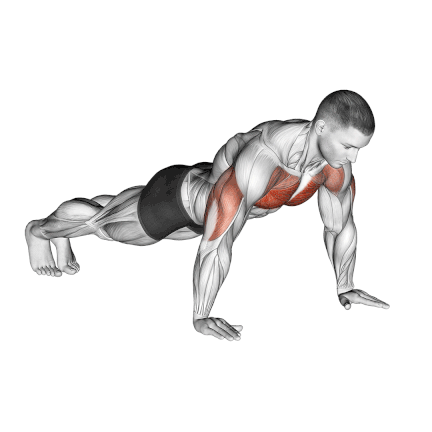
How To Do
- Place your hands shoulder-width apart, fingers pointing forward, with your arms supporting your upper body.
- Engage your core muscles – imagine you’re about to get punched in the stomach. This will keep your body in a straight line from head to heels.
- Now, push yourself up by straightening your arms. Think about pushing the floor away from you.
- Keep your elbows close to your body as you rise.
- Once your arms are fully extended, pause for a beat. This is the top of the movement; you should feel a good squeeze in your chest and shoulders.
- Slowly lower your body back down. Lower yourself until your chest is just away from the ground. Don’t let it touch!
- Push back up and repeat the movement. That’s one rep!
7. Overhead Press
The Shoulder Press Exercise is the best exercise for building shoulder muscle mass and strength. It remains the grand-daddy of all shoulder exercises to build big, round shoulder muscles.
The seated shoulder press is the favorite shoulder exercise among bodybuilders because it builds muscle fast and is a power move.
Note: Dumbbell Pres is also good for training the shoulder muscles. Research has shown that using dumbbells makes your muscles work harder, even if you can’t lift as much weight as compared to the barbell press.
There are several variations of the barbell press for shoulder development.
- Dumbbell shoulder press (single-arm, alternating)
- Standing military press
- Smith machine shoulder press
- Machine shoulder press
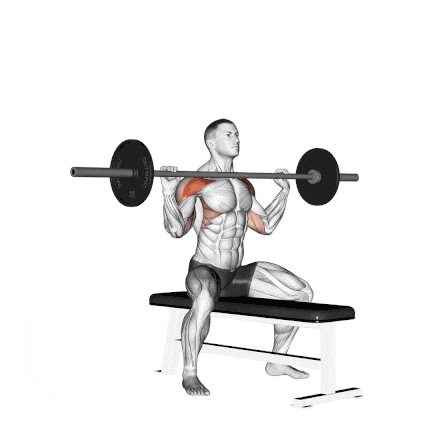
How To Do
- Sit on the bench with your feet flat on the floor and a slight bend in your knees.
- Grab the barbell with an overhand grip slightly wider than shoulder-width apart.
- Hold it at shoulder level, just above your upper chest, with your elbows bent and pointing forward.
- Extend your arms and press the barbell upward. As you push, focus on keeping the barbell balanced and moving in a straight line directly above your head.
- Pause for a moment and squeeze your shoulder muscles.
- Slowly lower the barbell back to the starting position.
8. Machine Press
Shoulder Machine Press is an excellent exercise to build the front deltoid and the side deltoid muscles.
Machine Presses have advantages over free weight presses. Machines provide better stability and safety and also offer a choice of handgrips. A neutral grip (palms facing together) targets the anterior deltoid better than a pronated grip (palms forward).
This exercise demands a very strict movement as the bar is fixed to the rack and also allows the weights to go much lower, providing a good stretch to front deltoid muscles.
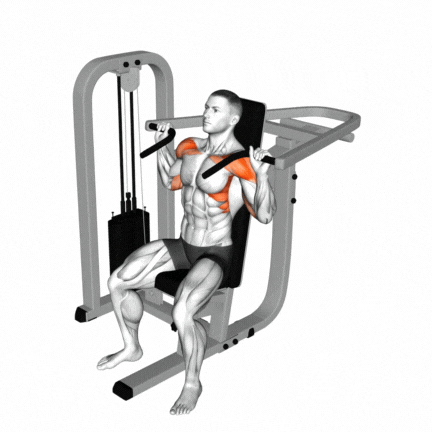
How To Do
- Grasp the handles with a comfortable grip, usually slightly wider than shoulder-width.
- Now press the bar overhead until your arms are nearly locked out.
- Lower the bar back to the starting position under controlled motion.
9. Lateral Raise
It is a simple yet effective exercise that can help you target the shoulders, particularly the lateral or middle deltoid muscles.
It involves lifting dumbbells out to the sides of the body while keeping the arms straight, making it an effective way to isolate and strengthen the shoulders.
You can add these lateral raise variations to your shoulder workouts.
- Dumbbell Lateral Raise (Standard)
- Cable Lateral Raise
- Leaning Lateral Raise
- Lying Lateral Raise
- Machine Lateral Raise
- Unilateral (Single-Arm) Lateral Raise
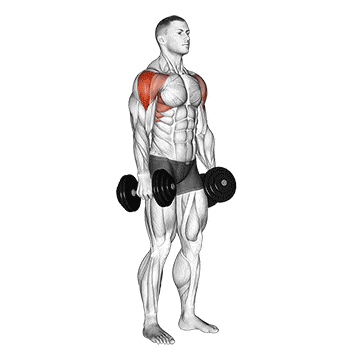
How To Do
- Hold a dumbbell in each hand and bring the weights together in front of you. The palms should be facing each other.
- Now bend your elbows and raise the dumbbells to your sides.
- Lift them to a point slightly higher than your shoulders.
- Now lower the dumbbells in a controlled manner back to the starting position.
- Don’t just swing your arms. Keep motion-controlled throughout the exercise.
10. Dumbbell Front Raise
Dumbbell front raise is an excellent exercise to isolate the anterior deltoid Muscle. This exercise helps to build muscle mass in the front head of deltoids.
Front dumbbell shoulder raises can be done standing or seated with a pair of dumbbells. They are also done in an alternating movement.
This exercise can work well with medium to lightweight for higher reps.
It’s a challenging exercise with heavy weights, so focus on growing the muscles rather than maxing out on a heavy load.

How To Do
- Stand holding a pair of dumbbells across the front of your thighs.
- Your feet are shoulder-width apart, and your knees are slightly bent.
- Raise one dumbbell (say right hand) in front, until it reaches just above shoulder level.
- Now lower the weight (of the right hand) while raising the left in front of you.
- Perform this exercise in this alternating manner.
11. Upright Row
The upright row is a compound weightlifting exercise that targets the muscles of the shoulder and upper back, including the deltoids, trapezius, as well as the rhomboids, and even the biceps — making it a great addition to any full-body workout.
There are three main variations of grip width: close grip, normal grip, and wide grip
- Close or narrow grip (half of shoulder width),
- A standard grip (shoulder width grip)
- A wide grip (wider than the shoulder)
Here are seven different ways to do an upright row using different equipment.
- Wide Grip Barbell Upright Row
- Dumbbell Upright Row
- Cable Upright Row
- One-Arm Dumbbell Upright Row
- Smith Machine Upright Row
- Kettlebell Upright Row
- Prone incline wide-grip upright row
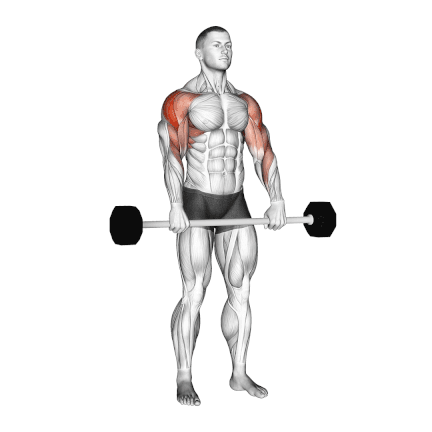
How To Do
- Stand with your feet shoulder-width apart to maintain a stable base.
- Hold a barbell with an overhand grip (palms facing you).
- Keep your back straight, shoulders relaxed, and chest lifted.
- Lift the bar straight up while keeping it as close to your body as possible (you should pull the bar up to around chest height).
- Pause, and then slowly lower the bar back to the starting position.
12. Rear Delt Fly
The dumbbell rear delt fly is a simple yet effective exercise that increases deltoid muscle definition and strength.
The rear delt dumbbell fly targets your upper back muscles and shoulder muscles, particularly the rear deltoids, (backside of your shoulders). It is one of the best to isolate and work specifically on For complete shoulder muscle development.
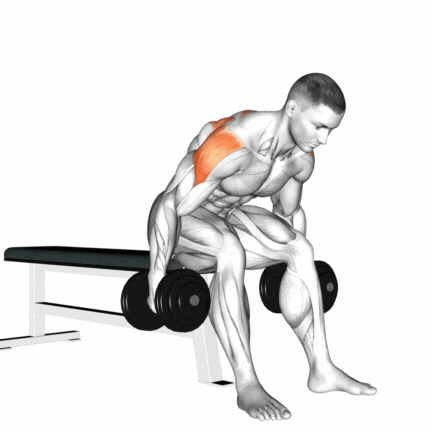
How To Do
- Hold a dumbbell in each hand with a neutral grip (palms facing each other).
- Bend forward at the hips while keeping your back straight.
- Your torso should be almost parallel to the floor.
- Keep your elbows slightly bent, and raise both arms out to the sides until the dumbbells are level with the height of your shoulders.
- Your body should resemble the letter ‘T’ at the top of the movement.
- Then slowly lower the dumbbells to the starting position.
How To Do Chest Shoulder Workouts (With Routines)
1. Weekly Workout Sets
According to the latest scientific evidence, 12–20 weekly sets per muscle group may optimize muscle growth.
- Beginners: ~10 sets per week.
- Intermediate: ~15 sets per week.
- Advanced: ~20 sets per week.
When a certain amount of volume stops being effective and your progress stalls, you can add sets to increase volume and use that as a driver of renewed progress.
2. Select Reps Range Based On Goals
To structure an effective chest shoulder workout to increase mass and strength, the no. of reps and sets will vary based on your fitness level, weekly workout frequency, and strength training goals.
- For strength gains, do 4 to 6 sets of 1 to 6 reps each exercise with a weight that is at least 85% of your one-repetition maximum (1RM) The fewer reps you perform, the closer to 100% of your 1RM you should strive for.
- If your goal is muscle hypertrophy (increased muscle size), perform 8 to 12 reps with loads i.e 70 to 85% of your 1RM.
- When training for endurance, use higher reps (15 to 20 repetitions) and moderate loads, weighing at least 50 to 70% of your 1RM.
It is always best to start with a lower number of reps and sets and then gradually increase as your strength improves
3. Design Your Chest and Shoulder Workout Split
Finding the right place for the chest and shoulder workout in your training split can greatly enhance your weight training routine. Find out how this combination works well with different workout schedules.
— 4-Day Split
- Day one: Chest and shoulders
- Day two: Back
- Day three: Quads and hamstrings
- Day four: Biceps and triceps
— Alternative Push/Pull/Legs Split
- Day one: Chest, shoulders, and triceps
- Day two: Back and biceps
- Day three: Lower body
— Customize Based on Your Schedule
Tailor your training split to accommodate your availability and preferences:
- Train four consecutive days, followed by a rest day
- Train two consecutive days, followed by a rest day
- Opt for Monday, Tuesday, Thursday, and Friday workouts, with weekends off
— Unleash Your Creativity
The integration possibilities are endless—let your imagination guide you:
- Experiment with different combinations and variations
- Personalize your training split to suit your goals and time constraints.
4. Beginner Chest and Shoulder Workout Routine
| Exercise | Sets | Reps | Rest Time |
|---|---|---|---|
| Push-ups | 4 | 10-12 | 60-90 sec |
| Dumbbell Bench Press | 4 | 10-12 | 60-90 sec |
| Dumbbell Shoulder Press | 3 | 10-12 | 60-90 sec |
| Dumbbell Flyes | 3 | 8-10 | 60-90 sec |
| Lateral Raises | 3 | 8-10 | 60-90 sec |
5. Intermediate Workout Routine
| Exercise | Sets | Reps | Rest Time |
|---|---|---|---|
| Barbell Bench Press | 4 | 8-10 | |
| Incline Dumbbell Press | 4 | 8-10 | 60-90 sec |
| Arnold Press | 4 | 8-10 | 60-90 sec |
| Cable Flyes | 4 | 10-12 | 60-90 sec |
| Seated Dumbbell Lateral Raises | 4 | 10-12 | 60-90 sec |
6. Advanced Workout Routine
| Exercise | Sets | Reps | Rest Time |
|---|---|---|---|
| Incline Barbell Bench Press | 4 | 6-8 | 60 sec |
| Dumbbell Pullover | 4 | 6-8 | 60 sec |
| Military Press | 4 | 6-8 | 60 sec |
| Dips | 4 | 8-10 | 60 sec |
| Standing Barbell Front Raises | 4 | 8-10 | 60 sec |
7. Chest and Shoulder Superset Workout
Try this superset of two different exercises without rest in between. You will be able to implement it easily and effectively into your workout.
| Superset | Exercise | Sets | Reps |
|---|---|---|---|
| Superset 1 | Dumbbell Bench Press (Immediately followed by) | 3 | 8-10 |
| Dumbbell Shoulder Press | 3 | 8-10 | |
| Superset 2 | Incline Dumbbell Fly | 3 | 10-12 |
| Lateral Raise | 3 | 10-12 | |
| Superset 3 | Decline Chest Press | 3 | To failure |
| Front Raise | 3 | 10-12 | |
| Superset 4 | Cable Chest Fly | 3 | 10-12 |
| Seated Dumbbell Shoulder Press | 3 | 8-10 | |
| Superset 5 | Push-ups | 3 | To failure |
| Bent-Over Dumbbell Rear Delt Flyes | 3 | 10-12 |
Note: Rest for 60-90 seconds between supersets. Adjust weights according to your fitness level and ensure proper form for each exercise.
FAQs
Can you train the chest and shoulder together?
Yes, you can train chest and shoulder together in your workout regime. It’s actually preferred by many fitness gurus and bodybuilders to train them together, since you are already working the shoulder when doing chest.
How Many Sets and Reps Should I Do?
For just about every exercise of the chest or shoulder, 3–4 work sets (the real work you do, not warm-up sets) is a good choice. But rep ranges fluctuate. You can go as low as 5 reps on heavy presses, and up to 15–30 reps for accessory work.
Should I do shoulders on chest day?
Yes, it’s normal to do shoulder exercises on chest day because the two muscles are connected. Combining them in a single workout can be an efficient way to target the upper body.
I hope you liked our chest and shoulder workout.
References
- J Hum Kinet. 2022 Feb 10;81:199-210. A Systematic Review of The Effects of Different Resistance Training Volumes on Muscle Hypertrophy.
- Hackett D.A., Johnson N.A., Chow C.M. Training Practices and Ergogenic Aids Used by Male Bodybuilders. J. Strength Cond. Res. 2013;27:1609–1617. doi: 10.1519/JSC.0b013e318271272a.
- Eur J Sport Sci. 2017 Sep;17(8):983-993. The effects of short versus long inter-set rest intervals in resistance training on measures of muscle hypertrophy: A systematic review.
- Int. J. Environ. Res. Public Health 2020, 17(19), 7339. Effect of Five Bench Inclinations on the Electromyographic Activity of the Pectoralis Major, Anterior Deltoid, and Triceps Brachii during the Bench Press Exercise.
- J Hum Kinet. 2020 Oct; 75: 5–14. Different Shoulder Exercises Affect the Activation of Deltoid Portions in Resistance-Trained Individuals.
- Int J Exerc Sci. 2020 Aug 1;13(6):859-872. Effects of Horizontal and Incline Bench Press on Neuromuscular Adaptations in Untrained Young Men.

Manish is a NASM-certified fitness and nutrition coach with over 10 years of experience in weight lifting and fat loss fitness coaching. He specializes in gym-based training and has a lot of knowledge about exercise, lifting technique, biomechanics, and more.
Through “Fit Life Regime,” he generously shares the insights he’s gained over a decade in the field. His goal is to equip others with the knowledge to start their own fitness journey.

